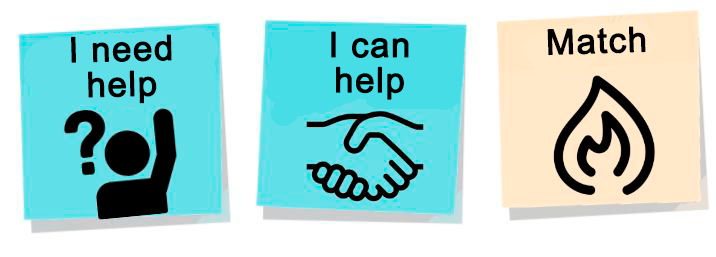Some time ago, I was with a team in which people kept their distance from one another. They spoke little, complained of similar problems, but nothing ever changed. I noticed those deeper problems didn’t come up easily in conversation and they often avoided talking about them. Management demands were increasing and this inhibited them in expressing what they were thinking, let alone asking for help.
In this scenario, one day I decided to do a retrospective with these people and noticed that the crux of the matter was they didn’t help each other or ask for help. That inspired me to do the exercise “I want to learn” and “I want to teach” for this retrospective.
The “Match-it” Retro consists of getting the team to work with the themes “I need help” and “I can help”. First, ask everyone to reflect on what they’re currently working on and which needs – or has needed – help. This help might be necessary because they’re overloaded, or because knowledge is centralized on one or a few people and needs sharing, or even because the task is boring, bureaucratic, etc., and which they want to finish in a hurry. It’s important to set a timebox, usually 2 or 3 minutes, for each to write down everything that needs help, one activity or task per post-it.

At the end of the given time, ask them one by one to share out loud what they wrote down and we put the post-its on the wall. What matters here is to make visible which tasks, activities or topics the team is working on where it’s possible for someone to help. Because very often people wrongly assume that help isn’t necessary or that they’ll “get in the way more than help”. It becomes easier to offer a helping hand when you know the other needs it and is open to receiving this assistance.
Once everyone can see where help is possible, ask them to write down how they can help. You should explain that this needn’t necessarily be something on the first list, but rather what knowledge they think it would be good to share, teach or learn as part of the team’s everyday work. Again, I give them a timebox of 2 or 3 minutes for each to write down one item per post-it. At the end of the allotted time, again ask them to read aloud what they’ve written down and then put the post-its on the wall.

Finally, we analyze the two lists together and look for matches, everything where someone needs help and there is one or more personable to help.

So the team creates a practical vision of how they can collaborate on a daily basis. After the exercise, ask the team to prioritize the more important actions they’ll carry out over the next week or two, and identify on the post-its who will help whom.
The result of the retro can remain as a living board, constantly being updated, so the team keeps coming back and reflecting on how to help each other more and more.
I hope this retro has also helped you readers in your daily work. Try it out and tell us in the comments how it went!
If you want to know more about our retrospectives, take a look at these posts.
And if you want to know more about one of our training, check out here!
